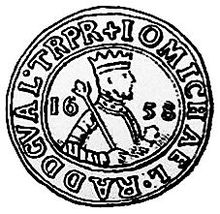Mihnea III
| Mihnea III | |
|---|---|
 | |
| Prince of Wallachia | |
| Reign | 5 March 1658 – November 1659[1] |
| Predecessor | Constantin Șerban |
| Successor | George Ghica |
| Born | 1613 Iaşi |
| Died | 5 April 1660 Sătmar |
| Father | Radu Mihnea (alleged, see § Ancestry claims) |
| Religion | Orthodox |

Mihnea III Radu (Turkish: Radu Gioan Bey; 1613 – 5 April 1660), was a Prince of Moldavia,[citation needed] and ruler of Wallachia from March 1658 to November 1659.[1] His father was alleged to have been the Voivode Radu Mihnea.[2][3]
Family
Ancestry claims
Radu's ancestry is uncertain. In his day, Radu claimed to be the son of Radu Mihnea, but other versions of his history give different accounts of his ancestry, such as claiming his true father was Radu Șerban or Mircea Ciobanu.[1] Pârvu Cantacuzino claims that "Mihnea was originally a Greek money-lender. His father was called Iane the Deaf (Rom. “Surdul”), and he himself was baptized Franți. Thus, showing from a young age a propensity to follow Ishmael, Hagar's son, he ran away from his parents, went to Țarigrad, and bowed in allegiance to Kinan-pașa, telling him that he was the son of Radu-voivode and the grandson of Mihnea-voivode. And thus he spent his life with the Turks, around 40 years".[1]
However, the lack of contemporary evidence makes it hard to pinpoint his true ancestry.[citation needed]
Descendants
He had one son, Martin, who served as a general in the army of George Ducas.[citation needed]
Biography
Early life
According to a Turkish traveller, Mihnea was raised in the Greek community of Istanbul.[citation needed] He was a good friend of Grand Vizier Kenan Pasha and his wife, and his status was reportedly comparable to that of an adopted son.[4]
Rise to power
In July 1653, Mihnea was probably behind an assassination attempt on Matei Basarab's life.[5]
On 29 January 1658, Mihnea swore allegiance to Ottoman Sultan[1] Mehmed IV.[6]
A little over a month later, Ottoman troops invaded Wallachia and overthrew then-voivode Constantin Șerban, installing the more compliant Radu in his place on 5 March 1658.[1]
Death
Mihnea most likely died on April 5, 1660, the day after attending a banquet in Sătmar hosted by Constantin Șerban.[7]
References
- ^ a b c d e f Feodorov (2014, p. 293)
- ^ Xenopol (1896, p. 131)
- ^ Diaconovich (1904, p. 278)
- ^ Feodorov (2014, pp. 293–4)
- ^ Secuiu (2016, p. 398)
- ^ Börekçi (2009, p. 370, "Mehmed IV")
- ^ Feodorov (2014, p. 306)
Bibliography
- Börekçi, Günhan (2009). Ágoston, Gábor; Bruce Masters (eds.). Encyclopedia of the Ottoman Empire.
- Diaconovich, Corneliu (1904) [1896]. Enciclopedia română (in Romanian). Vol. 3. W. Krafft.
- Feodorov, Ioana (January 2014). "Mihnea III Radu, Prince of Wallachia, as Seen by Paul of Aleppo and His Father Makāriyūs Ibn al-Zaʻīm, Patriarch of Antioch".
{{cite journal}}: Cite journal requires|journal=(help) - Secuiu, Micu (14 September 2016). Studii de istorie - ed. a II-a (in Romanian and German). Zekely Wilhelm. ISBN 9786068796031.
- Xenopol, Alexandru Dimitrie (1896). Istoria romãinilor din Dacia traiana (in Romanian).
